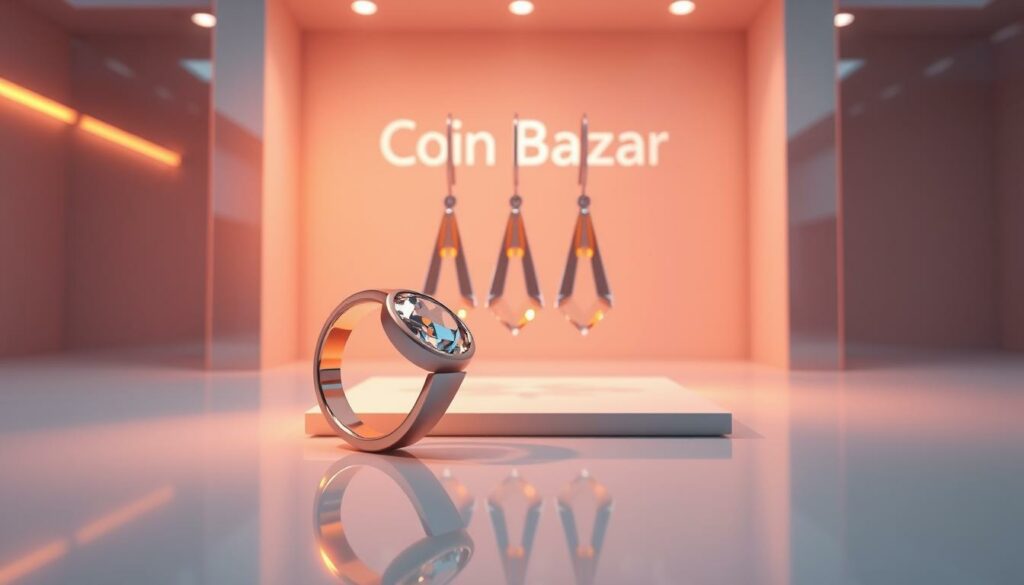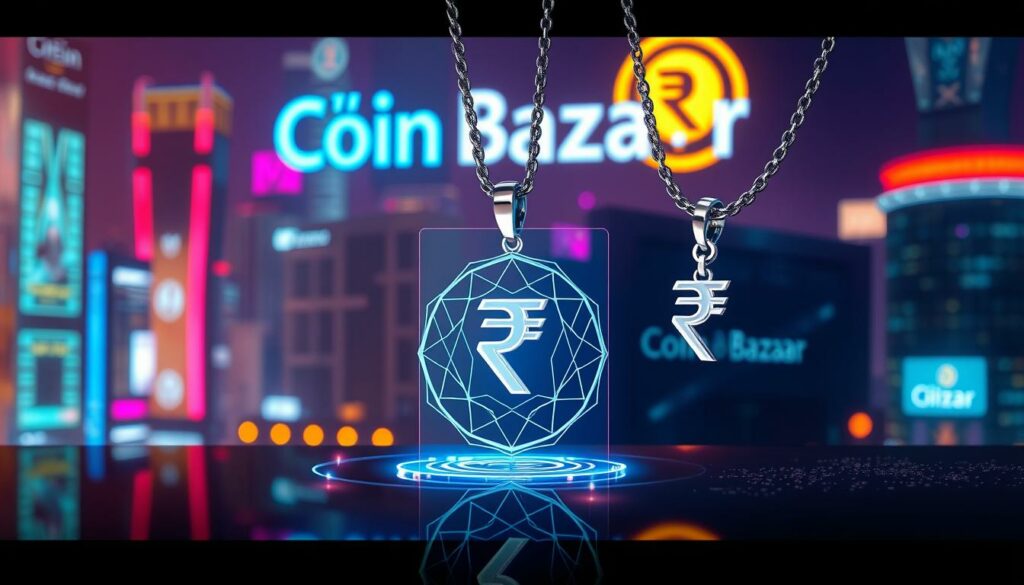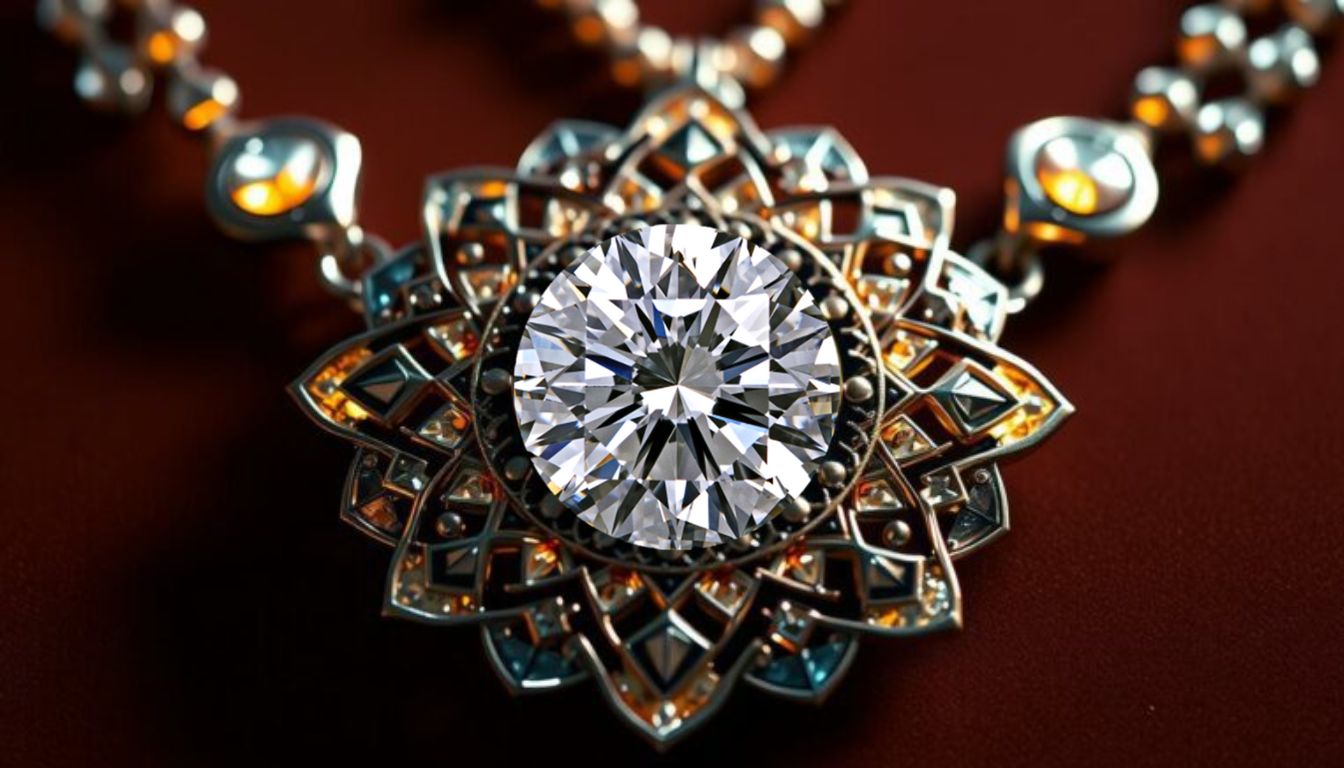You’ve probably heard about the metaverse. It’s a virtual world where people can interact, play, and shop. Luxury brands like Tiffany & Co. and Bulgari are already making digital jewelry. This makes the metaverse very interesting for the jewelry world.
The idea of designing jewelry for the metaverse is getting more attention. Many are unsure if it’s just hype or the next big thing. As virtual fashion and accessories grow in popularity, the jewelry industry is starting to take notice.
Key Takeaways
- Luxury brands are entering the metaverse with digital jewelry.
- The metaverse is a new frontier for jewelry design.
- Virtual jewelry is becoming increasingly popular.
- The jewelry industry is adapting to new technologies.
- Designing jewelry for the metaverse requires innovative thinking.
The Emergence of Virtual Fashion and Digital Accessories
Digital fashion is now a key part of virtual worlds. It lets users show off their style in new ways. You can express yourself through custom jewelry design without physical limits.


The Evolution of Digital Self-Expression
Our way of expressing ourselves is changing with virtual worlds. Digital accessories, like jewelry, are key in this change. They help users show their identity and style online. Here are some important points about digital self-expression:
- Personalization through jewelry design inspiration from different cultures and trends.
- The ability to easily change or update accessories, keeping your look current.
- A chance for designers to share their creativity and reach people worldwide.
Why Virtual Accessories Matter in the Metaverse Economy
Virtual accessories, like digital jewelry, are big in the metaverse economy. They make the user’s experience better and help the economy through sales and trades. As the metaverse grows, so will the need for unique digital accessories. This opens up chances for designers and creators.
Understanding the Metaverse Landscape for Designers
If you’re a jewelry designer, you might wonder about the metaverse. It’s a huge digital world where people can meet, chat, and even do business. For jewelry makers, it’s a chance to explore new ideas and find more customers.


Key Metaverse Platforms for Fashion and Accessories
Several platforms are becoming key for digital fashion and accessories. Decentraland and The Sandbox are two big names.
Decentraland and Its Fashion Districts
Decentraland is a virtual world where you can make, experience, and sell content. It has fashion areas where designers can show and sell their digital work. This place is all about creativity and connecting with buyers.
The Sandbox and Creator Opportunities
The Sandbox is another top metaverse spot for creators. It lets them build, own, and make money from their gaming and digital items. Designers have tools to make engaging and interactive jewelry.
Virtual Economies and Digital Ownership Principles
Knowing about virtual economies and digital ownership is key in the metaverse. Digital ownership uses NFTs (Non-Fungible Tokens) to prove and show the value of digital items. As a jewelry designer, you can make unique digital jewelry pieces using these technologies.
By understanding these platforms and economies, you can lead in the metaverse jewelry design trend. This way, you can meet the growing need for digital fashion and accessories.
The Intersection of Traditional Jewelry Design and Digital Realms
The mix of traditional jewelry design and digital worlds is creating new chances for creativity. In the metaverse, you can see how handmade jewelry design fits perfectly. It lets us make new, exciting jewelry in the virtual world.
Translating Physical Design Principles to Virtual Spaces
You can use old jewelry-making ways in digital design. This means you can add detailed textures and designs. It makes digital jewelry that feels real and special.
For example, filigree, a metalwork art, can be done digitally. This uses 3D software to make precise, detailed designs. It keeps the traditional feel but adds new levels of detail.
New Creative Possibilities Beyond Physical Limitations
Digital jewelry lets you go beyond what’s possible with real materials. You can make jewelry that seems to float or change shape. It’s a chance to create something truly unique and eye-catching.
Gravity-Defying Designs
In the digital world, jewelry can move and change in ways that real jewelry can’t. You can make pieces that float or change shape. This opens up new ways to wear jewelry in virtual settings.
Impossible Materials and Effects
With digital design, you can use materials and effects that are hard or impossible in real life. You can make jewelry that glows, changes color, or moves on its own. It’s a chance to explore new ideas and effects.
A famous jewelry designer said, “The metaverse is not just a new place; it’s a new way to see and make things.” This shows the exciting change happening in digital jewelry design.
| Design Aspect | Physical Limitation | Digital Possibility |
|---|---|---|
| Gravity | Jewelry is bound by gravity | Jewelry can float or defy gravity |
| Materials | Limited by available materials | Can use virtual materials with unique properties |
| Animation | Static pieces | Can incorporate dynamic animations |
By exploring digital jewelry design, you can make something truly new and exciting. It’s a chance to create pieces that amaze and connect with many people.
Designing Jewelry Specifically for the Metaverse
When you start designing jewelry for the metaverse, you’ll face unique challenges and opportunities. This virtual world is not just a new place; it’s a new space for creativity. Designers must think differently about jewelry design.
Understanding Avatar Proportions and Limitations
One key thing to think about when designing jewelry for the metaverse is the avatar’s proportions and limits. Avatars can vary in shape, size, and dimension, depending on the platform. Your jewelry needs to look good on all these different avatars.
- Think about scale: Jewelry that fits humans might be too big or too small for avatars.
- Make sure it fits the avatar’s virtual body: Your designs should either fit or look good with the avatar’s body.
Creating Wearable 3D Assets
The skill of making wearable 3D assets is crucial for metaverse jewelry design. It’s not just about how it looks. It’s also about how it works with the avatar’s movements and the virtual world.
- Think about the virtual setting: How light and surroundings affect your jewelry’s look is important.
- Make it move with the avatar: Design jewelry that moves smoothly with the avatar, making the virtual experience better.
Considerations for Different Virtual Platforms
Each metaverse platform has its own rules, limits, and what users like. When designing jewelry, you need to think about these things to make sure your designs work well and look good.
For example, some platforms might need specific file types, polygon counts, or texture sizes. Knowing these rules is essential for making great metaverse jewelry.
Technical Aspects of Metaverse Jewelry Creation
Exploring metaverse jewelry creation requires understanding technical aspects. It blends artistic creativity with technical skills. This ensures jewelry looks great and works well in virtual spaces.
Essential 3D Modeling Tools and Software
To make unique jewelry for the metaverse, knowing 3D modeling tools is key. These tools help create detailed designs for virtual worlds.
Blender for Jewelry Designers
Blender is a free, open-source 3D creation software. It’s versatile and widely used. For jewelry designers, Blender has tools for complex designs.
Specialized Jewelry Design Software
There’s also software made just for jewelry design. These programs have designs and templates to help. They have advanced features for jewelry making.
Rendering and Texture Mapping Techniques
Rendering and texture mapping are vital for your designs. Rendering turns 3D models into 2D images. Texture mapping adds detail. Techniques like UV unwrapping and normal mapping make designs look real.
| Technique | Description | Application in Jewelry Design |
|---|---|---|
| UV Unwrapping | Unwrapping a 3D model’s surface for texturing | Allows for detailed texture application on intricate jewelry pieces |
| Normal Mapping | Simulating detailed surface geometry without adding polygons | Enhances the appearance of complex jewelry details without increasing file size |
Animation and Movement Physics for Jewelry
Adding animation and movement physics makes jewelry designs more engaging. It simulates how jewelry moves on an avatar, adding realism.
Mastering these technical skills lets you create amazing, custom jewelry for the metaverse. Whether you’re experienced or new, the creative possibilities are endless.
NFTs and Digital Jewelry: The Technology Behind Ownership
NFTs are changing how we think about owning digital jewelry. They use blockchain technology to make sure ownership is secure and clear. This technology also makes digital jewelry rare and valuable.
Blockchain Basics for Jewelry Designers
Blockchain is key to NFTs. It’s a digital ledger that keeps track of transactions on a network. For jewelry makers, knowing blockchain basics is important for creating and managing digital jewelry.
Blockchain makes NFTs unique, verifiable, and tradable. It helps designers prove ownership and scarcity. This makes digital jewelry more valuable and sought after.
Creating Scarcity and Value in Virtual Items
It’s important to create scarcity and value in digital jewelry. Designers can do this by limiting NFTs or offering special content to owners.
| Method | Description | Impact |
|---|---|---|
| Limited Editions | Creating a limited number of NFTs | Increases perceived value |
| Exclusive Content | Offering exclusive content to NFT owners | Enhances ownership experience |
Minting and Selling Your Digital Jewelry Collections
After creating digital jewelry, you need to mint and sell it as NFTs. Minting turns your digital artwork into a unique NFT on a blockchain.
To sell your NFTs, list them on NFT marketplaces. It’s important to research popular platforms and understand their fees and rules for successful sales.
Contemporary Jewelry Design Trends in the Metaverse
The metaverse is changing how we see fashion and digital accessories. It’s a place where jewelry design trends are breaking new ground. Here, designers can show off their creativity in ways that are both beautiful and interactive.
Popular Styles and Aesthetics in Virtual Worlds
In the metaverse, minimalist designs are becoming popular. They feature clean lines and simple shapes. These designs are not only pretty but also work well in different virtual places.
On the other hand, maximalist designs are also trending. They have lots of details and bold looks. These designs let users show off their unique style.
- Geometric shapes and abstract forms
- Neon colors and glow-in-the-dark effects
- Interactive elements that respond to user movement
Case Studies of Successful Virtual Jewelry Collections
Luxury brands are diving into digital jewelry, with some seeing big wins. For example, a famous fashion brand launched a virtual jewelry line. It quickly became a hit, making a lot of money from NFT sales.
These stories show the power of virtual jewelry in the metaverse. They prove that contemporary jewelry design trends can lead to engaging and profitable digital products.
How Traditional Trends Translate to Digital Spaces
Even though the metaverse brings new chances for jewelry design, old trends still play a role. Designers are taking classic styles and making them fit the virtual world. For instance, Art Deco-inspired jewelry is being updated with digital touches, mixing old with new.
By knowing how to blend traditional trends with digital elements, you can make jewelry that appeals to many. It can be loved in both the real and virtual worlds.
Jewelry Design Inspiration for Metaverse Creators
Exploring the metaverse for jewelry design opens up a world of inspiration. It’s a place where the digital and physical worlds meet. This allows designers to think outside the box and be very creative.
Drawing from Physical World Aesthetics
Designers often look to the physical world for ideas. They take elements from nature, architecture, and historical jewelry and turn them digital. For example, ancient patterns can be reimagined in 3D, giving classic designs a new twist.
Sci-Fi and Fantasy Influences
Sci-fi and fantasy are rich sources of inspiration for metaverse jewelry. You can design pieces that look like alien artifacts or magical talismans. These designs attract fans of these genres and let you experiment with new materials and shapes.
Cultural and Historical References in Digital Design
Adding cultural and historical references to your designs can make them more meaningful. By using elements from different cultures and times, you can create pieces that are both beautiful and full of story. For instance, you could use symbols from various cultures in your digital jewelry.
| Inspiration Source | Design Elements | Metaverse Application |
|---|---|---|
| Physical World Aesthetics | Nature-inspired patterns, architectural details | 3D models, digital wearables |
| Sci-Fi and Fantasy | Alien artifacts, futuristic motifs | Virtual accessories, digital collectibles |
| Cultural and Historical References | Symbolic jewelry, historical motifs | Narrative-driven digital jewelry, cultural wearables |
By exploring different sources of inspiration, you can make unique jewelry for the metaverse. Whether you’re inspired by the physical world, sci-fi, or cultural heritage, the key is to mix traditional design with digital innovation.
The Business Model of Virtual Jewelry Design
Virtual jewelry design is growing fast. It’s key to know how it works for success. As a designer, you must understand the market well.
Pricing Strategies for Digital Accessories
Setting prices for digital items is different from traditional jewelry. Costs are often lower, but value to consumers matters. Some brands use prices that change with demand.
For example, a digital necklace might cost more when more people are online. Or, it could be sold with other items at a discount. Limited editions or exclusive designs can also raise prices by creating scarcity.
Marketing to Virtual Fashion Enthusiasts
Marketing to virtual fashion fans needs deep knowledge of their likes and habits. Use social media and influencer partnerships to show off your designs. Working with famous avatars or influencers can expand your reach.
Also, joining virtual fashion shows and events can boost your brand. Share behind-the-scenes content or tutorials on styling virtual jewelry to engage your audience.
Collaboration Opportunities with Virtual Platforms
Working with virtual platforms can bring in new money for your brand. You can make special content or add your designs to their worlds. This connects you with their users and grows your brand.
Building a Sustainable Digital Jewelry Brand
Creating a lasting digital jewelry brand needs a solid plan. Focus on making unique, quality designs that appeal to your audience. Regularly release new collections and interact with your fans to keep interest high.
Also, think about your brand’s environmental impact, like energy use for hosting your items. Share your efforts to build a brand that’s both successful and eco-friendly.
Custom Jewelry Design in the Metaverse
You can now make your own virtual jewelry that shows off your style in the metaverse. Custom digital jewelry is getting more popular. People want unique and personal experiences in virtual worlds.
Creating Bespoke Virtual Pieces
Designing jewelry for the metaverse means understanding its unique features. Digital pieces can have complex shapes and animations that real-world jewelry can’t. Advanced 3D modeling tools help designers add detailed touches and make jewelry that fits individual tastes.
Personalization Options and Technologies
Personalization is key in metaverse jewelry design. Tools like AI-driven design tools and 3D scanning help make jewelry that’s truly unique. Users can share their preferences, and the system creates designs just for them.
The Market for Custom Digital Accessories
The demand for custom digital accessories is skyrocketing. A recent study shows a big jump in the virtual jewelry market.
| Year | Market Size | Growth Rate |
|---|---|---|
| 2022 | $100M | 20% |
| 2023 | $120M | 25% |
| 2024 | $150M | 30% |
This growth shows a big opportunity for designers and brands in the custom digital jewelry market.
The Indian Market: Opportunities for Metaverse Jewelry
The Indian market is a big chance for metaverse jewelry. It’s fueled by a rich culture and a love for digital fashion. Knowing what drives this growth is key.
Cultural Significance of Jewelry in India
Jewelry is deeply rooted in Indian culture. It stands for wealth, beauty, and spiritual value. In the metaverse, these values can be expressed in unique digital pieces that appeal to Indian buyers.
Indian Consumers’ Adoption of Virtual Fashion
More Indians are getting into virtual fashion. This is thanks to social media and online games. The virtual fashion market is set to grow a lot in the future.
| Year | Virtual Fashion Market Size (India) |
|---|---|
| 2022 | $100 million |
| 2025 | $500 million |
| 2030 | $2 billion |
Success Stories from Indian Designers in the Metaverse
Indian designers are making waves in the metaverse with their digital jewelry. Their success shows the potential for Indian talent in this new field.
Traditional Motifs in Digital Spaces
Indian designers are mixing traditional motifs with digital designs. This creates a unique mix of old and new. It appeals to those who want to show their cultural roots.
Bridging Heritage and Technology
Technologies like 3D modeling and augmented reality help Indian designers merge old and new. This mix opens up new ways for designers to show their skills in the metaverse.
The Indian market is changing fast, and metaverse jewelry is key to its future. By understanding the cultural importance, consumer trends, and designer success, you can find your place in this growing field.
Professional Jewelry Design Career Paths in the Metaverse
The metaverse is changing the game for jewelry designers, offering new challenges and chances. As virtual worlds grow, the need for skilled designers who make unique digital jewelry is increasing. You can take advantage of this trend by learning the skills needed to succeed in this new world.
Skills Required for Success
To do well in the metaverse, you’ll need both traditional jewelry design skills and new digital design abilities. Key skills include:
- Proficiency in 3D modeling software such as Blender or Tinkercad
- Understanding of virtual reality (VR) and augmented reality (AR) technologies
- Knowledge of texture mapping and rendering techniques
- Familiarity with blockchain technology for creating NFTs (Non-Fungible Tokens)
As Emily Chen, a leading metaverse jewelry designer, says, “The metaverse has opened up new avenues for creativity and innovation in jewelry design. Designers who adapt quickly to the digital realm will be well-positioned for success.”
Building Your Portfolio and Reputation
Having a strong online presence is key in the metaverse. You can build your portfolio by:
- Creating a diverse range of digital jewelry pieces
- Participating in virtual fashion shows and exhibitions
- Collaborating with other designers and influencers in the metaverse
Income Potential and Business Models
The metaverse offers different ways for jewelry designers to make money, including:
| Business Model | Description | Potential Income |
|---|---|---|
| NFT Sales | Selling unique digital jewelry pieces as NFTs | $100-$10,000 per sale |
| Commissioned Designs | Creating custom jewelry for clients in the metaverse | $500-$5,000 per design |
| Subscription Services | Offering exclusive digital jewelry content to subscribers | $10-$50 per month per subscriber |
As the metaverse grows, so will the opportunities for jewelry designers. By learning the right skills, building a strong portfolio, and exploring different business models, you can have a successful career in this exciting new world.
Future Predictions: Where Is Metaverse Jewelry Heading?
New technologies are changing the world of metaverse jewelry. We’re on the edge of big changes in how we see digital jewelry.
Emerging Technologies Shaping the Future
Artificial Intelligence (AI) and Machine Learning (ML) are key for metaverse jewelry’s future. They will make digital jewelry more complex and personal, giving users special experiences.
AI can create detailed designs based on what users like. ML will make digital jewelry look more real by using real-world physics and materials.
Integration with Augmented Reality and Wearables
Metaverse jewelry is also merging with Augmented Reality (AR) and wearables. AR lets users see how digital jewelry looks in real life. This connects virtual and physical fashion.
Wearables will make this experience even better. They’ll let users interact with their digital jewelry in new ways, like with gestures.
The Convergence of Physical and Digital Jewelry
As tech gets better, we’ll see physical and digital jewelry come together. This could mean jewelry that has digital parts or digital jewelry that turns into physical pieces.
This mix is exciting for designers. It lets them try new things and create unique jewelry.
For those designing jewelry for the metaverse, knowing these trends is key. Designers who stay ahead can make jewelry that’s not just beautiful but also immersive.
Conclusion: Navigating the Future of Jewelry in Virtual Worlds
The metaverse is changing the jewelry world, offering new chances for designers and brands. You’ve seen how jewelry design is now mixing virtual and real elements. Custom jewelry in virtual worlds is also getting more popular.
You can now make unique, custom pieces that show off your style and live in the virtual world too. This change is making jewelry design, marketing, and buying different.
To move forward in this new area, designers and brands need to be open to change and new ideas. By diving into the metaverse, you can lead the way and meet the growing need for virtual jewelry.
The future of jewelry will blend physical and digital parts. By getting how these two worlds meet, you can explore new ideas and thrive in this exciting field.














